Properties
| Storage Buffer | PBS pH 7.4, 50% glycerol, 0.09% sodium azide *Storage buffer may change when conjugated |
| Storage Temperature | -20ºC, Conjugated antibodies should be stored according to the product label |
| Shipping Temperature | Blue Ice or 4ºC |
| Purification | Peptide Affinity Purified |
| Clonality | Polyclonal |
| Specificity | Binds to acetylated lysine 77 on HSP70. Detects 70 kDa band. |
| Cite This Product | StressMarq Biosciences Cat# SPC-743, RRID: AB_2706545 |
| Certificate of Analysis | A 1:1000 dilution of SPC-743 was sufficient for detection of HSP70 Acetyl Lys77 in 10 µg of human HeLa cell lysates by ECL immunoblot analysis using goat anti-rabbit IgG:HRP as the secondary antibody. |
Biological Description
| Alternative Names | HSP70 Acetylated lysine 77 Antibody, HSP70 acLys77 Antibody, HSP70 acK77 Antibody, Acetylated Lysine HSP70 Antibody, HSP70 AcetylLys77 Antibody, HSP70 AceyltK77 Antibody, DnaK type molecular chaperone HSP70 1 antibody, Epididymis secretory protein Li 103 antibody, Heat shock 70 kDa protein 1 antibody, Heat shock 70 kDa protein 1/2 antibody, Heat shock 70 kDa protein 1A/1B antibody, Heat shock 70kDa protein 1A antibody, Heat shock 70kDa protein 1B antibody, Heat shock induced protein antibody, HEL S 103 antibody, HSP70 1 antibody, HSP70 1B antibody, HSP70 2 antibody, HSP70-1/HSP70-2 antibody, HSP70-1A antibody, HSP70.1 antibody, HSP70.1/HSP70.2 antibody, HSP70I antibody, HSP71_HUMAN antibody, HSP72 antibody, HSPA1 antibody, HSPA1A antibody, HSPA1B antibody |
| Research Areas | Cancer, Cell Signaling, Chaperone Proteins, Heat Shock, Protein Trafficking, Tumor Biomarkers |
| Cellular Localization | Cytoplasm, Nucleus |
| Accession Number | NP_005336.3 |
| Gene ID | 3303 |
| Swiss Prot | P0DMV8/P0DMV9 |
| Scientific Background | HSP70 genes encode abundant heat-inducible 70-kDa HSPs (HSP70s). In most eukaryotes HSP70 genes exist as part of a multigene family. They are found in most cellular compartments of eukaryotes including nuclei, mitochondria, chloroplasts, the endoplasmic reticulum and the cytosol, as well as in bacteria. The genes show a high degree of conservation, having at least 50% identity (2). The N-terminal two thirds of HSP70s are more conserved than the C-terminal third. HSP70 binds ATP with high affinity and possesses a weak ATPase activity which can be stimulated by binding to unfolded proteins and synthetic peptides (3). When HSC70 (constitutively expressed) present in mammalian cells was truncated, ATP binding activity was found to reside in an N-terminal fragment of 44 kDa which lacked peptide binding capacity. Polypeptide binding ability therefore resided within the C-terminal half (4). The structure of this ATP binding domain displays multiple features of nucleotide binding proteins (5). All HSP70s, regardless of location, bind proteins, particularly unfolded ones. The molecular chaperones of the HSP70 family recognize and bind to nascent polypeptide chains as well as partially folded intermediates of proteins preventing their aggregation and misfolding. The binding of ATP triggers a critical conformational change leading to the release of the bound substrate protein (6). The universal ability of HSP70s to undergo cycles of binding to and release from hydrophobic stretches of partially unfolded proteins determines their role in a great variety of vital intracellular functions such as protein synthesis, protein folding and oligomerization and protein transport. For more information visit our HSP70 Scientific Resource Guide at http://www.HSP70.com. |
| References |
1. Welch W.J. and Suhan J.P. (1986) J Cell Biol. 103: 2035-2050. 2. Boorstein W. R., Ziegelhoffer T. & Craig E. A. (1993) J.Mol. Evol. 38(1): 1-17. 3. Rothman J. (1989) Cell 59: 591-601. 4. DeLuca-Flaherty et al. (1990) Cell 62: 875-887. 5. Bork P., Sander C. & Valencia A. (1992) Proc. Nut1 Acad. Sci. USA 89: 7290-7294. 6. Fink A.L. (1999) Physiol. Rev. 79: 425-449. 7. Galan A., et al. (2000) J. Biol. Chem. 275: 11418-11424. 8. Kondo T., et al. (2000) J. Biol. Chem. 275: 8872-8879. 9. Misaki T., et al. (1994) Clin. Exp. Immun. 98: 234-239. 10. Pockley A.G., et al. (1998) Immunol. Invest. 27: 367-377. 11. Moon I.S., et al. (2001) Cereb Cortex 11(3): 238-248. 12. Dressel et al. (2000) J. Immunol. 164: 2362-2371. 13. Verma A.K., et al. (2007) Fish and Shellfish Immunology. 22(5): 547-555. 14. Banduseela V.C., et al. (2009) Physiol Genomics. 39(3): 141-159. |
Product Images
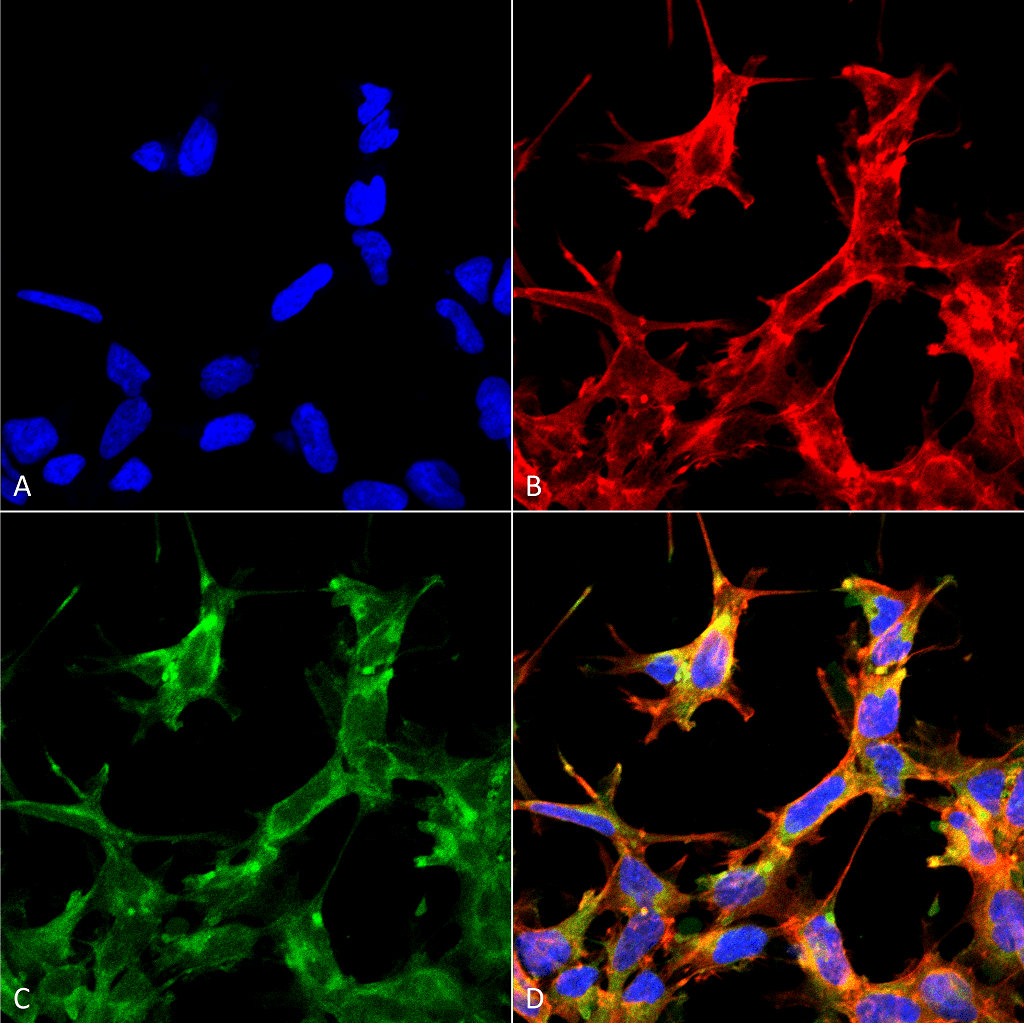
Immunocytochemistry/Immunofluorescence analysis using Rabbit Anti-HSP70 Acetyl Lys77 Polyclonal Antibody (SPC-743). Tissue: Embryonic kidney cells (HEK293) cultured overnight with 50 µM H2O2. Species: Human. Fixation: 5% Formaldehyde for 5 min. Primary Antibody: Rabbit Anti-HSP70 Acetyl Lys77 Polyclonal Antibody (SPC-743) at 1:60 for 30-60 min at RT. Secondary Antibody: Goat Anti-Rabbit Alexa Fluor 488 at 1:1500 for 30-60 min at RT. Counterstain: Phalloidin Alexa Fluor 633 F-Actin stain; DAPI (blue) nuclear stain at 1:250, 1:50000 for 30-60 min at RT. Localization: Cytoplasmic. Magnification: 20X (2X Zoom). (A) DAPI (blue) nuclear stain. (B) Phalloidin Alex Fluor 633 F-Actin stain. (C) HSP70 Antibody (Acetyl Lys77). (D) Composite. Courtesy of: Dr. Robert Burke, University of Victoria.
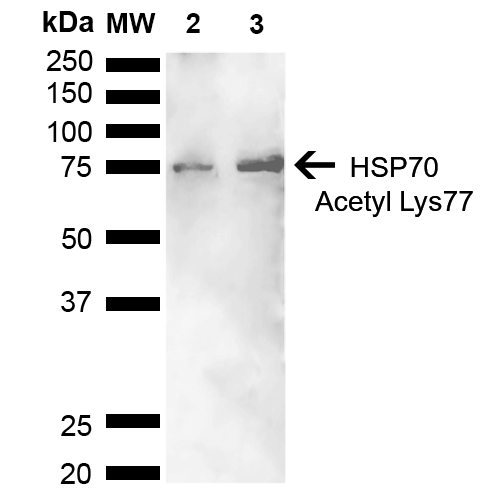
Western blot analysis of Human Cervical cancer cell line (HeLa) lysate showing detection of ~70 kDa HSP70 Acetyl Lys77 protein using Rabbit Anti-HSP70 Acetyl Lys77 Polyclonal Antibody (SPC-743). Lane 1: Molecular Weight Ladder (MW). Lane 2: Cervical Cancer cell line (HeLa) lysate. Lane 3: H2O2 Cervical Cancer cell line (HeLa) lysate. Load: 10 µg. Block: 5% Skim Milk in 1X TBST. Primary Antibody: Rabbit Anti-HSP70 Acetyl Lys77 Polyclonal Antibody (SPC-743) at 1:1000 for 2 hours at RT. Secondary Antibody: Goat Anti-Rabbit HRP:IgG at 1:3000 for 1 hour at RT. Color Development: ECL solution for 5 min at RT. Predicted/Observed Size: ~70 kDa.
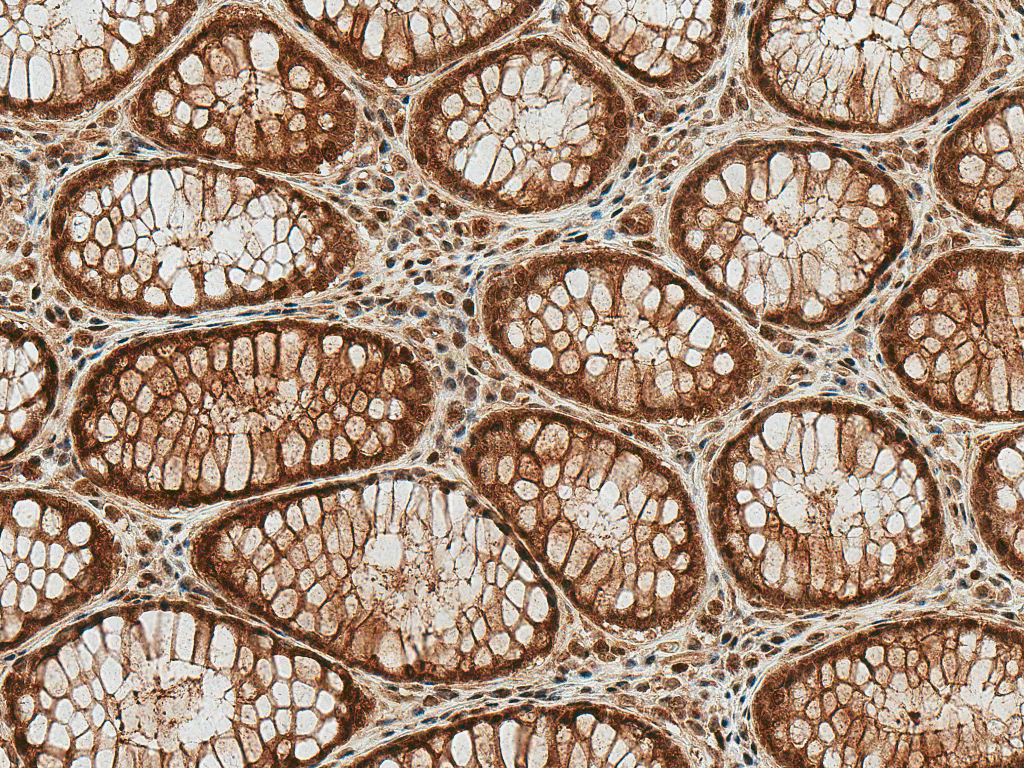
Immunohistochemistry analysis using Rabbit Anti-HSP70 (Acetyl Lys77) Polyclonal Antibody (SPC-743). Tissue: Colon Cancer. Species: Human. Fixation: Formalin Fixed Paraffin-Embedded. Primary Antibody: Rabbit Anti-HSP70 (Acetyl Lys77) Polyclonal Antibody (SPC-743) at 1:50 for 30 min at RT. Counterstain: Hematoxylin. Magnification: 20X. HRP-DAB Detection.

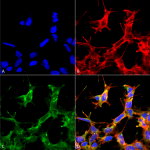
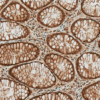
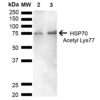




















StressMarq Biosciences :
Based on validation through cited publications.